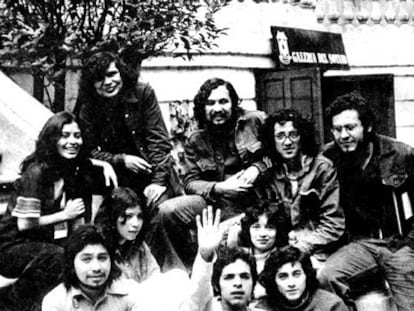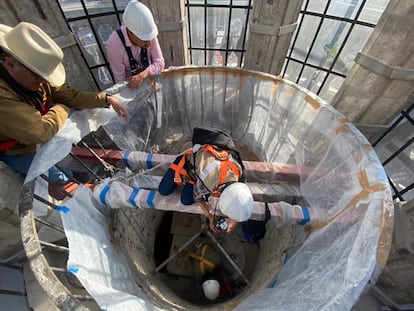Luz Jiménez, the indigenous woman who was more than a muse for Mexican muralists
The little-known model frequently appeared in works by Diego Rivera, David Alfaro Siqueiros and Jean Charlot
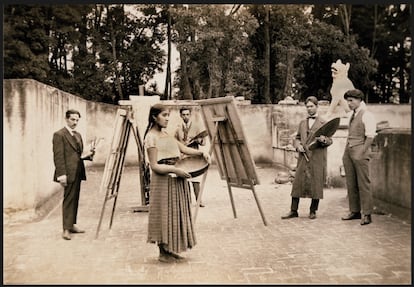
Luz Jiménez is the rural teacher that Diego Rivera painted on Mexico’s Ministry of Public Education walls. She is also the peasant woman Rivera portrayed next to the insurgents in the National Palace. Jiménez is the indigenous woman with braids selling snacks in Rivera’s Dream of a Sunday Afternoon in Alameda Park, and the figures representing faith, wisdom and tradition in his Creation mural. She is the naked Malinche José Clemente Orozco painted next to Hernán Cortés on the steps of San Ildefonso College and the woman with the lyre that Rufino Tamayo drew in the old National Conservatory of Music. Jiménez is the naked woman with the water pitchers under each arm in the Mexico Park sculpture, the mother Jean Charlot portrayed with her daughter, and the woman Fernando Leal painted crossing herself. She is a constant presence who has often gone unnoticed.
“Luz Jiménez is something of a legend for many people,” says historian Carmen Tostado. Although she was a central figure in the national image projected by Mexican muralism in the early 20th century, most people don’t know who she was. “If you mention Frida Kahlo or Nahui Olin, everyone knows who they are. I don’t think many people know the name, Luz Jiménez. But she’s a constant presence. How many people pass by the fountain in Mexico Park with a 10-foot statue of a naked woman yet don’t know the model’s name?” Tostado is one of the curators of The Spirit of 1922, an exhibition at San Ildefonso College, a museum and cultural center in Mexico City, considered the birthplace of the Mexican muralism movement. In the early 20th century, “Luz Jiménez was the face of Mexican art,” says Tostado.
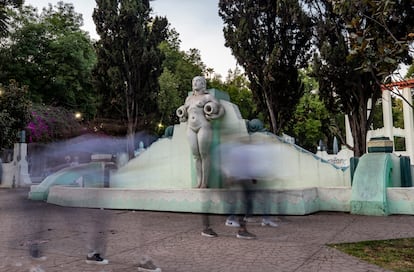
Luz, Luciana, Lucha or Juliana; Martínez, Pérez, Jiménez and González – the model used many names before settling on Luz Jiménez. But she was born Julia Jiménez in the late 19th century in Milpa Alta, an area of wooded hills on the southern fringe of Mexico City. At 19, the Mexican Revolution came to her town when federal troops massacred her father and many other men. Jimenéz fled with her mother and sisters and eventually settled in Santa Anita, the first Open Air Painting School site. The art school was premised on providing San Carlos Academy students an opportunity to escape their stuffy confines and the traditions of European painting. “That is where the two worlds of Luz Jiménez and the artists met,” explains Tostado.
Jesus Villanueva is the grandson of Luz Jimenéz and the keeper of her archives. In his book, Luz Jiménez, símbolo de un pueblo milenario 1897-1965 (Luz Jiménez, Symbol of a Millenary People), Villanueva writes, “No one knows exactly how she became involved in art.” One theory is that the painters persuaded her to model after she won a beauty contest. Another version says she answered a job advertisement that only required “standing still.” Although Jimenéz died when Villanueva was three, he devoted himself to studying her life and promoting her legacy. Luz Jiménez always “sought to better herself.” Perhaps that ambition led her to become a central figure in Mexican art.
Old receipts kept by the family show the artists paid her about a dollar a week for modeling. To make a bit more money, she also worked for them as a maid and cook, according to Villanueva’s book. In a 1961 Excélsior newspaper article, Luz Jiménez said that whenever Diego Rivera needed her, he would come into town to fetch her. “I was like another piece of furniture for them [the artists],” she said. But Jiménez also became a friend to many of them, especially Jean Charlot, the godfather of her daughter, Concha. The French-born painter may have taught Jimenéz the French lullabies she sang to her grandchildren later in life. On Christmas Eve 1925, Jimenéz cooked dinner for Charlot and his friends, including photographer Edward Weston, who wrote in his published diaries, “Luziana cooked a tasty Mexican meal – what hot chilis! Conchita was the most important guest.”

Luz Jiménez invited muralist Fernando Leal on a pilgrimage to the Christ of Chalma sanctuary, southwest of Mexico City. Leal later painted a mural depicting the experience on the walls of San Ildefonso between 1922 and 1923 called The Feast of the Christ of Chalma. The mural pictures an enraptured dancer staring straight ahead, surrounded by masked people, girls dressed in white, peasants with candles and other celebrants. Luz Jiménez appears three times in the mural – the woman crossing herself, the woman wearing the blue shawl over her head and the woman in the blue-and-black-striped skirt with her back turned. “What does this mean? That it’s a complex relationship? Or perhaps a complete relationship? I don’t know,” says Tostado. “Luz knew how to communicate her world; that’s why they went looking for her [to model]. There were many pretty indigenous girls, but she had a way of drawing them in and developing friendships. There was mutual interest and recognition of each other’s world. I imagine her posing patiently and watching them [the artists] with the same curiosity as they watched her,” she says.
Matylda Figlerowicz is a literary critic and art historian who says that “she [Jimenéz] can be described as a point of gravity” for artistic circles of the time. “She wanted to be there and was good at modeling. By all accounts, she was very charismatic and looked like how people thought an indigenous woman should be represented in art.” Historian Blanca Garduño describes her as having “an oval face, strong and rounded chin, straight and braided hair, dark complexion and robust figure.” Art critic Alberto Híjar writes of a “body type that met expectations” and “represented the national identity.” However, Figlerowicz says, “If we only consider [her indigenous features], we don’t do her justice because she was pictured in so many different ways.”
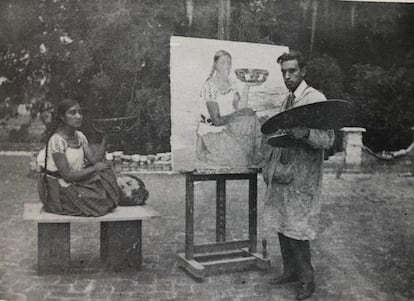
Figlerowicz, a fellow at Harvard University, is studying Jiménez’s “broad intellectual body of work.” In her essay, “The Shaping of Luz Jiménez’s Image,” Figlerowicz says the anthropologists and linguists she worked with “called her an ‘informant,’ but she was more of a teacher and author.” Figlerowicz and other scholars have recently sought to “change the narrative” about the life and work of Jiménez. For example, she taught Jean Charlot the Nahuatl language, and an account of her life and recollections of the Mexican Revolution were recorded by Fernando Horcasitas in De Porfirio Díaz a Zapata: Memoria náhuatl de Milpa Alta (Life and Death in Milpa Alta: A Nahuatl Chronicle of Diaz and Zapata). But Figlerowicz says the only publications that bear her name are two articles in the Nahuatl-language Mexihkatl Itonalama newspaper, edited by anthropologist Robert Barlow. “It was never a stable source of income for her,” says Figlerowicz. “Everyone wanted her around, but they didn’t treat her as an equal.”
On her way to work one morning, Luz Jiménez was run over and killed when she was 68. The newspapers that carried her obituary noted that she was “well known in art and anthropology circles,” but she was largely forgotten after her death. At a conference in 2021, her grandson said a 1994 exhibition of Jean Charlot’s work revived his grandmother’s memory. “They realized she was a model who had impacted the artists,” Villanueva says. After that, curators organized four exhibitions dedicated to Luz Jimenéz, including one by the Diego Rivera and Frida Kahlo museum in 2000.
The Google Doodle for January 28, 2023, celebrated the 126th birthday of Luz Jimenéz and spread the word around the world about the “most painted woman of Mexico” who, nevertheless, “remained relatively unknown.”
Sign up for our weekly newsletter to get more English-language news coverage from EL PAÍS USA Edition
Tu suscripción se está usando en otro dispositivo
¿Quieres añadir otro usuario a tu suscripción?
Si continúas leyendo en este dispositivo, no se podrá leer en el otro.
FlechaTu suscripción se está usando en otro dispositivo y solo puedes acceder a EL PAÍS desde un dispositivo a la vez.
Si quieres compartir tu cuenta, cambia tu suscripción a la modalidad Premium, así podrás añadir otro usuario. Cada uno accederá con su propia cuenta de email, lo que os permitirá personalizar vuestra experiencia en EL PAÍS.
¿Tienes una suscripción de empresa? Accede aquí para contratar más cuentas.
En el caso de no saber quién está usando tu cuenta, te recomendamos cambiar tu contraseña aquí.
Si decides continuar compartiendo tu cuenta, este mensaje se mostrará en tu dispositivo y en el de la otra persona que está usando tu cuenta de forma indefinida, afectando a tu experiencia de lectura. Puedes consultar aquí los términos y condiciones de la suscripción digital.
More information
Archived In
Últimas noticias
Most viewed
- Reinhard Genzel, Nobel laureate in physics: ‘One-minute videos will never give you the truth’
- Oona Chaplin: ‘I told James Cameron that I was living in a treehouse and starting a permaculture project with a friend’
- Pablo Escobar’s hippos: A serious environmental problem, 40 years on
- Chevy Chase, the beloved comedian who was a monster off camera: ‘Not everyone hated him, just the people who’ve worked with him’
- Why we lost the habit of sleeping in two segments and how that changed our sense of time
